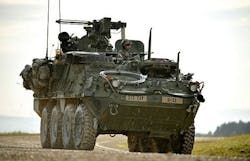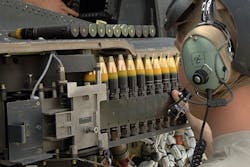General Dynamics to equip Stryker combat vehicle with 30-millimeter cannon unmanned turret
Officials of the Army Contracting Command in Warren, Mich., announced a $75.3 million contract in mid-January to General Dynamics Land Systems in Sterling Heights, Mich., to design and integrate the unmanned 30-millimeter cannon turret for the Stryker, as well as build eight prototype gun platforms.
This unmanned turret would enable Stryker crews to engage targets and defend their vehicle from attackers safely from inside the armored combat vehicle. Most likely it would involve electro-optical sensors on the turret and electronic displays inside the vehicle to enable a gunner to operate the cannon turret from cover.
The Stryker family of eight-wheeled armored fighting vehicles from General Dynamics Land Systems is a derivative of the Canadian LAV III combat vehicle from a General Dynamics-General Motors Defence Canada team, and is based on the Swiss Piranha III 8×8 combat vehicle.
Related: Elbit Systems' Brazilian subsidiary to provide Brazilian Army with unmanned turrets
Stryker is designed as a deployable fighting vehicle that is more lethal than light vehicles like Humvees, yet lighter and more maneuverable than heavyweight combat vehicles like the M1 Abrams main battle tank.
Addition of 30-millimeter cannon turret to the Stryker would boost the vehicle's firepower substantially. A 30-millimeter cannon bullet is about 10 inches long, while a .50 caliber machine gun bullet is about five inches long, and a 7.62 millimeter machine gun bullet is about three inches long.
While .50 caliber and 7.62 millimeter machine guns primarily are anti-personnel rounds for fighting enemy soldiers, the 30-millimeter cannon is an anti-materiel or armor-piercing round that are effective against other armored vehicles and are capable of penetrating fortified bunkers.
Related: Raytheon to build 22 new anti-tank turrets for Marine Corps Light Armored Vehicle
The 30-millimeter cannon bullet comes in three varieties: armor-piercing, high-explosive, and training rounds. Armor-piercing and high-explosive cartridges typically have incendiary characteristics that can cause secondary fires on and inside targets.
The Stryker armored combat vehicle is named for two American servicemen who posthumously received the Medal of Honor: Private First Class Stuart S. Stryker, who died in World War II, and Specialist Four Robert F. Stryker, who died in the Vietnam War.
On this contract General Dynamics Land Systems will do the work in Sterling Heights, Mich., and should be finished by January 2021. For more information contact General Dynamics Land Systems online at www.gdls.com, or the Army Contracting Command-Warren at www.acc.army.mil.


